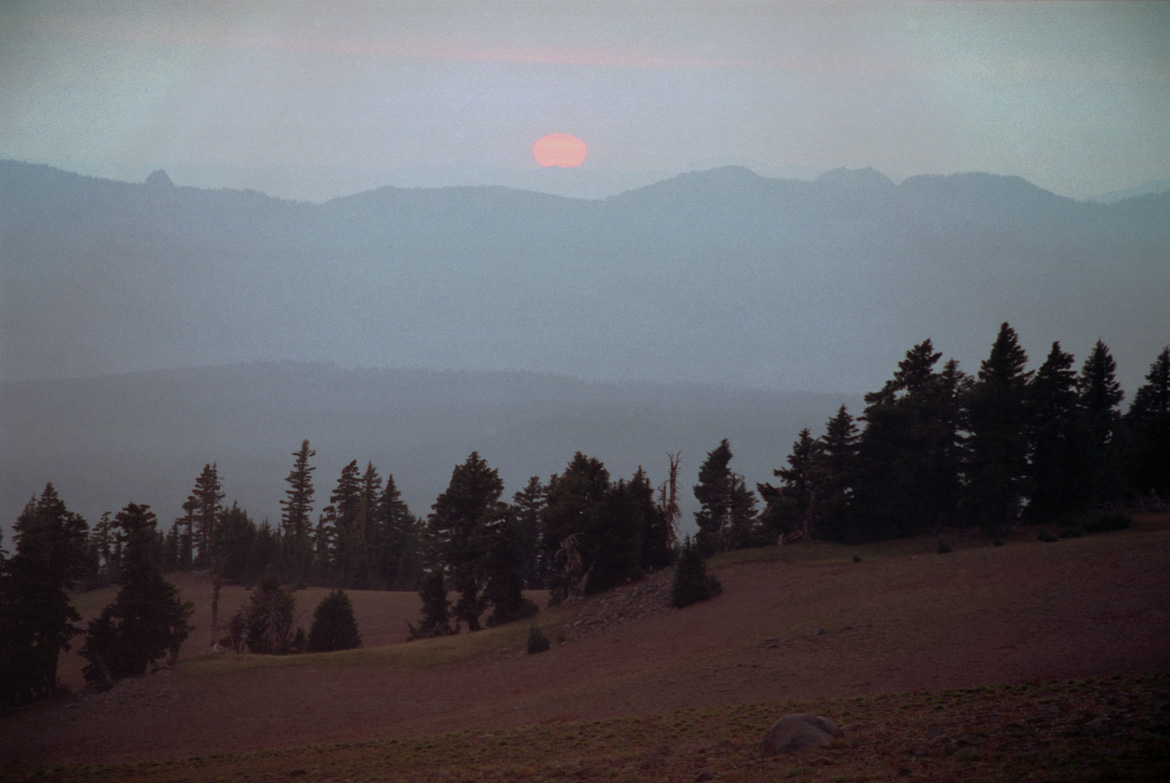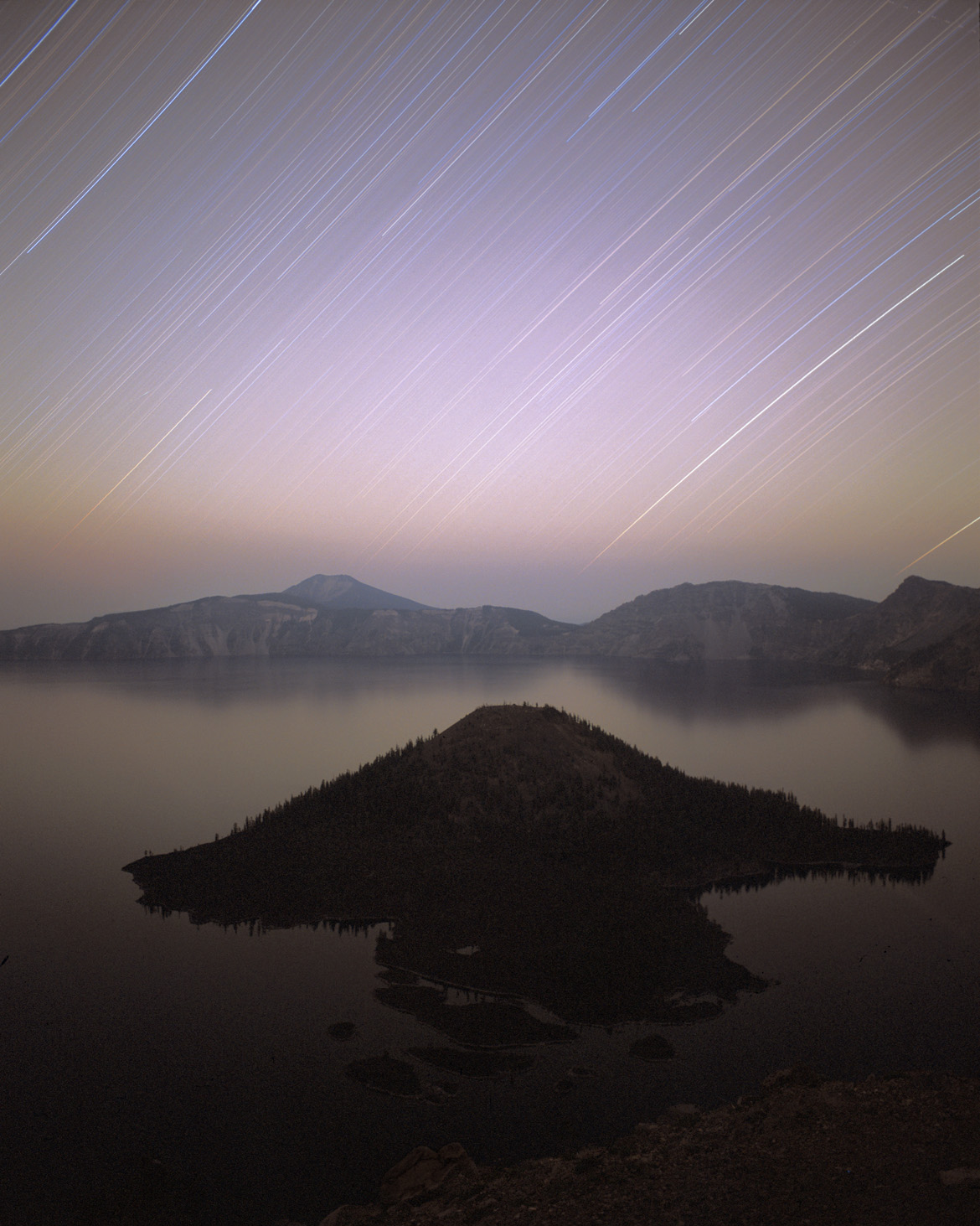6.1 Forest Fire Crater Haze
Though it doesn’t seem so from the maps, Crater Lake is not an easily accessible park. It is tucked away in a zone straddling forest and desert, and only a few roads provide access.
I stopped in the town of Roseburg, the exit point from the I5 freeway to start the blue-highways route to Crater Lake. This was the last town of a size that might have an adequate camera store. I needed a cable release to replace one that had failed. A cable release, the mechanism that provides long duration exposures by keeping the shutter open, is essential for astrophotography. It works by using a flexible wire inside a sleeve. One end has a pushbutton plunger that is used to push the sliding wire down the sleeve, acting as a “finger extender” to trip the shutter. This allows you to take a picture without actually touching the camera with your shaky hands. When the camera is set to “B” (a reference to the now obsolete flash bulb-mode), the shutter remains open for as long as the cable is pushed in. For really long exposures, there is a convenient feature on the cable release that lets you lock it in place, allowing you to walk away from the whole setup while the shutter remains open. Come back in an hour and unlock it to finish the exposure.
I am surprised at how often cable releases have let me down. I had learned early on that the simpler models using a set-screw to lock the cable should be avoided. They just can’t be operated while wearing gloves, and even without gloves, it’s hard to be sure that the set-screw is tight enough and won’t slip sometime during the exposure.
The more professional cable releases use some kind of mechanical interlocking ring to accomplish the task. There are still hazards of setting it correctly, but it CAN be done with gloves. It turns out however that there are other weak points in the design of a cable release, specifically the endpoints of the sleeve and where it connects to the plunger, and to the camera. If these become loose, the cable has nothing to push against and becomes useless. This is what had brought me looking for a replacement. The tip had detached from the sleeve during a previous night’s shooting. My attempt to do a repair in the dark only resulted in the tip getting lost somewhere in the wild, or in my car, which is about the same thing.
Cable releases are becoming a relic of the past however. Modern cameras use infrared or electronic remote controls, truly decoupling the camera from your shaky hand; it takes a camera store of a certain stature to carry the old-style mechanical ones. It was not clear that Roseburg was large enough to host such a camera store.
I decided that Roseburg was just at that critical threshold, because I did manage to find a camera store that carried camera accessories, including cable releases, but the selection was limited. There was one. Its features were exactly wrong, it was way too long (I like the shortest ones so they don’t get tangled in the dark), and had a screwlock, and it was outrageously expensive, but there I was, at the edge of civilization at the last possible source for this essential gadget. I bought it.
The road provides access to Crater Lake, but when it is under construction, that access is even more restrictive. Patience is the requisite virtue for this trip, but because of the delays, I reached the park in the late afternoon. The sun, still an hour or two above the horizon was a dramatic red orb, viewed directly through a thick atmospheric haze. This was a summer of record forest fires throughout the Northwest, and though I had not encountered any directly along my routes, they had filled the air for weeks with their particulate exhaust. The afternoon light was warmer than usual.

I would have liked to find a campsite, but my construction-detained late arrival (pre-sunset doesn’t seem late to me) rewarded me the experience of seeing the “Campground Full” sign. There was no time to figure out my overnight accommodations, nor for any extensive reconnaissance, I needed to find my shooting location for that night. I still held out hope that maybe I could catch some late Perseids on film.
I found an overlook for the beautiful lake that gave a nice view to the East, and set up two of my cameras to try and catch meteors. The strategy is to use a fast lens at its full-open aperture, open the shutter and hope a meteor crosses its field before a few minutes elapses, at which point you may as well close the shutter, advance, and try again, because the background sky level will have fogged the film. If a meteor does strike while the shutter is open, close it immediately, and start the next frame. I thought I could manage this procedure on two cameras.
While I was trying to catch meteors, my third camera was exposing a long startrail shot. Crater Lake is famous for its calm blue reflecting waters, and I had been looking forward to this chance to get reflected trails in the scene, a motivation for coming here in the first place. Unfortunately, the famous calm blue reflecting waters were not calm and not blue. The weather conditions that had fanned the flames of the forest fires were still active, and the wind managed to find its way over the normally protective rim of the crater and ruffle the surface of the lake. The haze in the sky lent a yellowish cast, though I could not tell this as I composed the frame.
I spent several hours waiting to catch meteors. I did see a few; the long graceful distinctive trail of a Perseid meteor was a momentary reward for suffering the wind. I could not tell what the film was seeing, but I dutifully advanced frames when it was time. The wind seemed to spill over the crater wall at exactly this overlook, or maybe I’m just easily annoyed by it, but after a few hours it had extracted the warmth from my core, and it just wasn’t fun anymore. I was tired again and was coming to realize that I should really plan on burning the evening on a traveling day, because it wouldn’t be very successful anyway.
Now, back to that problem of no room at the inn. It was late, and I found an unpopulated picnic area. The rules are always no overnight camping, but I was going to sleep somewhere, and this looked like a secluded place that wouldn’t attract picnickers until the next morning. I put my windshield reflector in place (for privacy, not the heat shielding), and made myself as comfortable as a 6-foot human can in a minivan filled with astrophoto equipment. I was skeptical that I would be able to sleep in this contorted position, but just after thinking this was impossible, it was suddenly light out. I must have closed my eyes for a brief moment during the time warp.
Not refreshed, but not dead exhausted anymore, I planned my new day. It was still early, the campground was probably coming to life, led by the segment of our population called early birds, people whose body chemistry prevents them from physical activity if it is dark out. This causes them to miss the glories of the night sky, but also results in a pent-up energy level that must be released as soon as dawn’s twilight arrives. These are the people found jogging at five a.m. and who have breakfast cooked, dishes cleaned, camp packed up, and are on the road by six!
As a member of the remainder of the population, the night owls, I usually curse this frenetic early morning activity. Today however, I took advantage of this behavior, scouting the campground for their early vacancies. There! I moved in to an open site, enjoying the experience of claiming a campsite even before the Campground Full sign had been taken down. It is not often I am the first one to check in!
One can always divide the world into two types of people– distinguishing between early birds and nightowls is just one. My favorite division is between those who divide the world into two types of people, and those who don’t. I suspect that anyone declaring themselves as belonging in this latter group would have to acknowledge that they are different from the former, thereby placing them into the group to which they claim not to belong!



Pingback: 5 Tillamook Friends and the Lost Perseids | Thor's Life-Notes
Pingback: 6.2 Crater Lake Rim Drive | Thor's Life-Notes